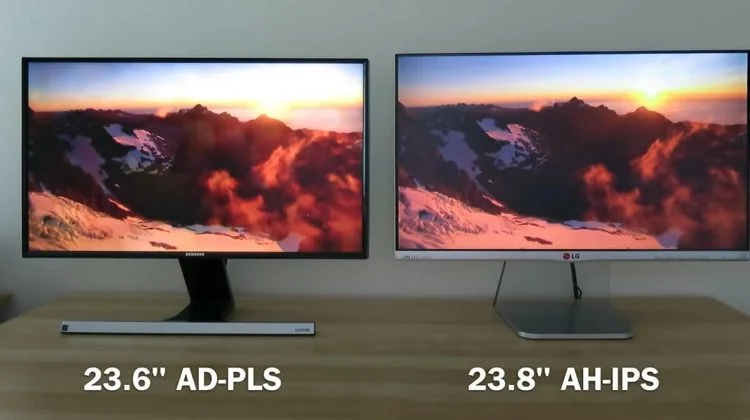What Is a PLS Screen?
PLS (Plane-to-Line Switching) is Samsung’s take on wide-angle TFT LCD technology, offering a powerful alternative to traditional IPS panels.
At its core, a PLS display uses the same horizontal alignment of liquid crystals as IPS—but with patented twists designed to:
- Deliver striking color uniformity, even from off-axis views
- Improve light transmittance, yielding brighter visuals at the same power
- Enhance overall image quality with Samsung’s proprietary refinements
PLS appears most often in Samsung-branded monitors, tablets, and professional-grade devices where consistent color across the screen is essential—even though it’s less widespread than IPS in the broader market.
What Is an IPS Panel?
IPS (In-Plane Switching) is the industry-standard wide-angle LCD technology found across brands like LG, Dell, and Apple. It was originally developed by Hitachi and gained traction for its:
- Ultra-wide viewing angles (up to 178°) with minimal color shift
- High color accuracy and depth suitable for color-critical applications
- Exceptional consistency across entire screen surfaces
This reliability has made IPS the default choice for high-end monitors, medical displays, creative tools, and precision industrial UIs.
PLS vs. IPS: How Do They Compare?
Here’s a side-by-side look at how PLS stacks up against IPS across key metrics:
| Merkmal | PLS Screen | IPS-Panel |
|---|---|---|
| Betrachtungswinkel | Excellent (≈178°) | Excellent (≈178°) |
| Color Uniformity | Very high | Industry benchmark |
| Brightness Efficiency | Slightly higher | Depends on panel grade |
| Contrast & Black Level | Moderate (≈1000:1) | Slightly superior on premium IPS |
| Ansprechzeit | ~5–8 ms | ~5–8 ms |
| Cost Efficiency | Often more affordable | Varies with brand and quality |
| Ecosystem & Supply | Samsung-centric | Broad support (LG, AUO, BOE etc.) |
In practice, engineers often see PLS as Samsung’s optimized version of IPS. It delivers comparable or slightly better performance in some areas—especially perceived brightness and price—while staying true to IPS’s visual strengths.
Are PLS Screens Better Than IPS?
Not exactly—but not worse either.
For most users and industrial applications, the differences between PLS and IPS are subtle. However, here are a few practical distinctions worth noting:
- Power or brightness optimization: PLS panels may require less backlight for a given luminance, so they can deliver the same brightness with lower energy.
- Color-critical applications: Premium IPS panels, including variants like AH-IPS or Nano IPS, may still hold an edge for ultra-precise color workflows.
- Supply chain considerations: PLS is Samsung-specific, while IPS offers a broader vendor base—important for long-term procurement.
Where IPS Still Leads
IPS remains the go-to in settings where visual fidelity matters most:
- Professional photo/video editing and color grading
- Medical diagnostic displays
- High-end consumer tablets (e.g., iPads, Surface devices)
- Automotive infotainment systems demanding wide viewing angles
- Industrial user interfaces where consistent quality is key
Due to its broad manufacturer support and myriad panel grades, IPS offers flexibility in feature-rich or regulated applications.
Choosing Between PLS and IPS for Your Display Project
Here’s a practical matrix to help you decide:
| Anwendung | Recommended Panel |
|---|---|
| General office or industrial GUI | PLS oder IPS |
| Budgetsensitive Hardware-Bereitstellungen | PLS |
| Farbgenaue Content-Erstellung | IPS (Premium-Klasse) |
| Hohe Helligkeit oder Anforderungen an Outdoor-Displays | PLS oder hochwertiges IPS |
| Breiter Display-Herstellerzugang und Kompatibilität | IPS |
Ihre endgültige Wahl sollte auch Panel-Abmessungen, Schnittstellenkompatibilität (RGB, MIPI, LVDS), Helligkeitsziele, Budget und langfristige Verfügbarkeit berücksichtigen.
Häufig gestellte Fragen
F1: Sind PLS-Bildschirme nur umbenanntes IPS?
Nicht genau. PLS verwendet ähnliche Flüssigkristall-Physik, beinhaltet jedoch technische Optimierungen von Samsung – beispielsweise bessere Lichtdurchlässigkeit und Fokus auf Gleichmäßigkeit.
F2: Verbrauchen PLS-Panels weniger Strom?
Manchmal. Aufgrund verbesserter optischer Effizienz können sie bei gleichem Strombudget die gewünschte Helligkeit mit weniger Hintergrundbeleuchtung erreichen.
F3: Kann ich bei IPS und PLS die gleiche Farbwiedergabe erwarten?
Bei den meisten Mittelklasse-Panels ja – die Unterschiede sind subtil. In hochwertigen IPS-Panels für den Farbprofibereich können geringe Verbesserungen in der Konsistenz spürbar sein.
F4: Kann ich ein IPS-Display in meinem Produkt durch ein PLS-Panel ersetzen?
Ja – vorausgesetzt, die Panel-Größen, Timing-Spezifikationen und elektrischen Schnittstellen stimmen überein. Möglicherweise müssen Sie Display-Abstimmung oder Farbzuordnung anpassen.
F5: Welches schneidet im Freien besser ab?
PLS kann eine bessere Helligkeitseffizienz pro Watt bieten, aber beide profitieren erheblich von optionaler optischer Bonding oder Entspiegelungsbeschichtungen.
Abschließende Gedanken
Beide PLS und IPS bieten exzellente Betrachtungserlebnisse, breite Farbgamuts und starke Betrachtungswinkel. Wenn Sie Display-Module für Embedded Systems beziehen – insbesondere Samsung-kompatible – kann PLS Kosten senken und die Helligkeit steigern. Wenn Sie breite Herstelleroptionen und fortschrittliche Farbabstimmungspräzision benötigen, bleibt IPS in puncto Flexibilität unübertroffen.
Kurz gesagt: Keines ist von Natur aus besser, aber jedes hat seinen optimalen Anwendungsbereich, abhängig von Ihren Anwendungsbedürfnissen.

